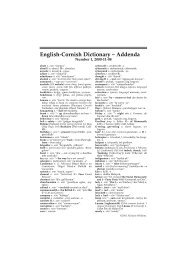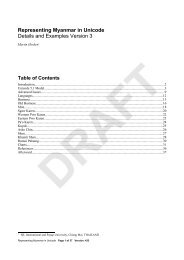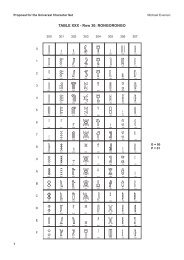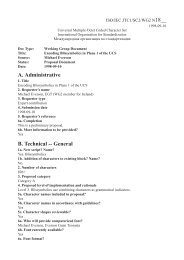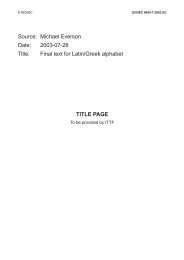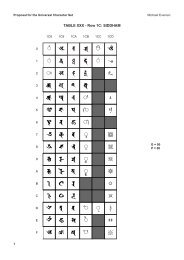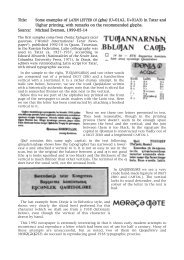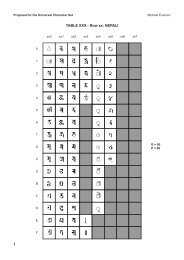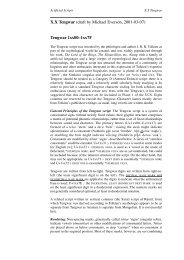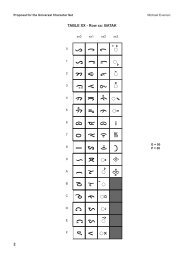ISO/IEC JTC1/SC2/WG2 N3xxx L2/07-xxx - Evertype
ISO/IEC JTC1/SC2/WG2 N3xxx L2/07-xxx - Evertype
ISO/IEC JTC1/SC2/WG2 N3xxx L2/07-xxx - Evertype
Create successful ePaper yourself
Turn your PDF publications into a flip-book with our unique Google optimized e-Paper software.
The most convenient way of naming the characters is to identify them with their standard Egyptological<br />
catalogue numbers, since otherwise the character names would be picturesque but rather long. The name<br />
EGYPTIAN HIEROGLYPH E034 refers uniquely and unambiguously to the DESERT HARE character used for the<br />
sound wn. Character names are padded with zeros here for two reasons. First, they will tend to sort<br />
correctly even when “smart” sorting algorithms are not available. Second, the use of zeros offers a<br />
mechanism for distinguishing UCS character names from the many extant naming schemes for Egyptian,<br />
since formally-standardized UCS characters will have a different status than font collections like<br />
Hieroglyphica (Grimal et al. 1993 and 2000) or other works. Gardiner uses A44 for › KING OF UPPER<br />
EGYPT WITH FLAGELLUM; Collier and Manley (whose numbering is completely idiosyncratic) use A44 for<br />
fi ARM HOLDING THE NH. BT-WAND; Möller uses A44 for fl SOLDIER WITH BOW AND QUIVER. The UCS<br />
names for › A044, fi D045, and fl A012 uniquely identify the characters and also identifies the<br />
designation as a UCS name.<br />
According to Gardiner’s identification scheme, Egyptian Hieroglyphs are classified according to letters<br />
of the alphabet, so A000 is “Man and his occupations”, B000 is “Woman and her occupations”, C000 is<br />
“Anthropomorphic deities”, D000 is “Parts of the human body”, E000 is “Mammals”, F000 is “Parts of<br />
mammals”, G000 is “Birds”, H000 is “Parts of birds”, I000 is “Amphibious animals, reptiles, etc.”, K000<br />
is “Fishes and parts of fishes”, L000 is Invertebrata and lesser animals”, M000 is “Trees and plants”,<br />
N000 is “Sky, earth, water”, O000 is “Buildings, parts of buildings, etc.”, P000 is “Ships and parts of<br />
ships”, Q000 is “Domestic and funerary furniture”, R000 is “Temple furniture and sacred emblems”,<br />
S000 is “Crowns, dress, staves, etc.”, T000 is “Warfare, hunting, butchery”, U000 is “Agriculture, crafts,<br />
and professions”, V000 is “Rope, fibre, baskets, bags, etc.”, W000 is “Vessels of stone and earthenware”,<br />
X000 is “Loaves and cakes”, Y000 is “Writings, games, music”, Z000 is “Strokes, signs derived from<br />
Hieratic, geometrical features”, and AA000 is used for “Unclassified” signs. (Note: some individual<br />
characters have been may have been identified as bellonging to other classes since the category was<br />
assigned but we have not re-assigned them.) In Gardiner 1929, 1931, and 1953 a section Ff “Signs for<br />
transcription from Hieratic” appears, but as these are identified as variants of other characters, they are<br />
named accordingly here (for example, since ◊ G1928:95:Ff2 is a “substitute for ÷ V7”, it is named<br />
V0<strong>07</strong>A). In Gardiner 1953, a section Nn is given to represent the nomes of Egypt, with L prefixed to the<br />
number for the nomes of Lower Egypt, and U for the nomes of Upper Egypt. All of those characters are<br />
related to ‚ N024, which indicates land marked out with irrigation runnels, which is presumably why<br />
Gardiner used the notation “Nn” for the nomes. Gardiner gives NnL1 for „; the naming convention here<br />
calls it NL001 rather than NNL001. An aesthetic complaint might be made about O000, but Gardiner<br />
used the letter O in his classification and we maintain that the leading zero is a useful convention for the<br />
reasons given above.<br />
Gardiner identified some variants of characters by unique catalogue numbers, and others by extending<br />
adding one or two asterisks (and in one instance a and a'). UCS naming convention does not allow the<br />
use of asterisks, but it is traditional to add letters of the alphabet, as has been done here. Thus Gardiner’s<br />
‡ G7, · G7*, and ‚ G7** are G0<strong>07</strong>, G0<strong>07</strong>A, and G0<strong>07</strong>B here respectively. Letters for variants are to<br />
be added serially as the Egyptian repertoire in the UCS is expanded.<br />
7. Character set repertoire. The first set of hieroglyphs which should be encoded, and which is<br />
proposed here, is “the Gardiner set”, which is something of a moving target. “The Gardiner set” was not<br />
exhaustively described and enumerated by Gardiner or indeed by anyone else. The chief source of the<br />
repertoire is Gardiner’s Middle Egyptian sign-list as given in his Egyptian Grammar (Gardiner 1957).<br />
This is supplemented by additional characters found in his font catalogues (Gardiner 1928, Gardiner<br />
1929, Gardiner 1931, and Gardiner 1953), and a collection of signs found in the Griffith Institute’s<br />
Topographical Bibliography, which also used the Gardiner fonts. In consultation with Egyptologists, a<br />
handful of other characters has been added to this set forming the proposal here. The following criteria<br />
have been used as guidelines to determine the contents of repertoire.<br />
3





